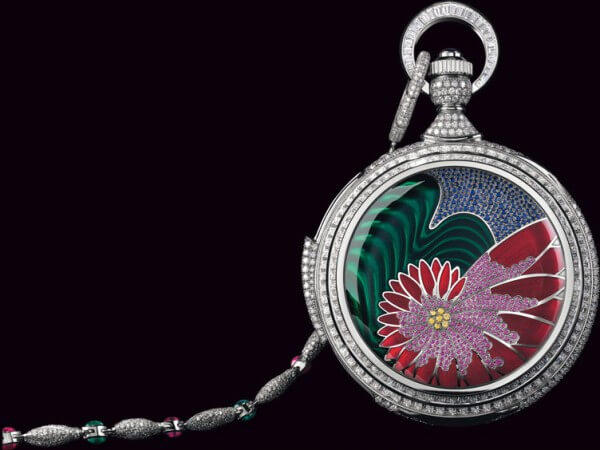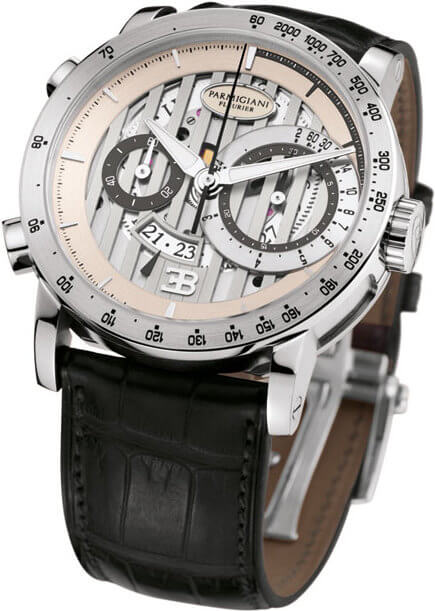Speaking at the Salon International de la Haute Horlogerie, Michel Parmigiani, the man behind the eponymous brand, talked about an aspect of watchmaking expertise without which the industry wouldn’t be what it is today.
Michel Parmigiani: We are continuing the Bugatti story with the Atalante, inspired by the car of the same name, the Bugatti Atalante 57S Sport, one of the few 1930s sports coupes. This flyback chronograph is fitted with the PF 335 Manufacture movement. It replaces the Type 370 wristwatch with tubular movement of which we are ending production having reached 200 pieces, each sold for CHF 200,000 (EUR 136,000).At Parmigiani, we prefer to limit production rather than flood the market so as to preserve the brand’s spirit. We prefer to promote rarity and in doing so add to the intrinsic value of the timepiece over the years.
As announced last September, we are pursuing our partnership with Bugatti, also with a seven-day Tourbillon that will feature on the instrument panel of the future Galibier. This model, with its avant-garde mechanics, is in every way characteristic of our desire for exclusive movements. This watch can be taken out of the dashboard and transformed into a wristwatch, pocket watch or desk clock. Otherwise, we have made certain slight modifications or adaptations to our existing models for our 2010 collections to maintain their appeal without making sweeping changes.
To come back to your question, I never fail to find inspiration in Fibonacci’s studies of the mathematics of harmonies. His observation of patterns in nature nurtures my own research into the harmony of proportions, one of the distinctive qualities of the brand. In this sense, I feel a little like the guardian of the temple, intent on safeguarding the science of the past and the savoir-faire of enamellers, stone-setters, chasers and that bastion that is complication watchmaking. This continuity of knowledge is the key to preserving all of these arts.

As a restorer of timepieces, these professions are very important to me. I could say that five hundred years of watchmaking history have passed through my hands. This is why I’m very much attuned to the promotion and mastery of this savoir-faire, these techniques, some of which I regret to say have died out, particularly in enamel. If you look at some of the pieces in the Sandoz Collection, which is being shown at the SIHH 2010, and how the gold has been worked, we would be incapable of achieving such feats of artistry today.
I’ve always had these disciplines at heart. Each engraver, for example, has a unique touch which they acquire over time. Only through true understanding can they achieve what they set out to achieve.In the old days, it was often by rising to the challenge to create a work of great art that craftsmen surpassed themselves. This challenge, the desire to prove something can be done, has given us many marvels. For these reasons, we must remain humble with respect to our forefathers who produced surprising results given the means at their disposal, and which we find hard to imitate even with the best modern resources. Restoration develops an analytical mind, trains the eye and teaches us to be efficient. Which doesn’t mean we must always disregard modern technologies, which enable us to do some amazing things such as laser soldering.
The pieces in the Sandoz Collection clearly rank among the many very interesting items I’ve been asked to restore. An artist, musician and poet, Maurice-Yves Sandoz compiled a collection of veritable wonders, thanks to his artistic sensitivity and his ability to recognise a fine piece of workmanship. It is our duty to continue in this vein and take inspiration from these marvellous objects. Just as environmental questions concern us all, in industry in particular, it is our role to maintain and promote this body of knowledge.
Contemporary watchmaking, it has to be said, is first and foremost a business. A business that generates a certain degree of sameness and, because of this, a gradually diminishing need for these arts. Which is why we need to implement safeguards. The Qualité Fleurier label is one. It came about after observing a decline in the quality of mechanical watches. It is a universal measure of finished watches based on precise criteria of quality and finish. Because the bar is so high, of course an operation of this kind has a cost, and if financial considerations prevail then all that soon goes out the window. Similarly, I wonder if it’s a good thing that a watch group be publicly listed, as it seems financial concerns do indeed impose their law.
As for us, we’ve decided to make our watches from the case to the dial via every single component, including the strategic ones. This means heavy investments and a costly strategy that is far-removed from the marketing approach that currently prevails. Which is why, as I’ve said before, understanding and mastery are so important. We have laid the industrial and human foundations with which to perpetuate the brand. But unlike the manufactures of before who produced a type of consumer good, the objects we make are clearly objets d’art.















